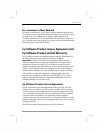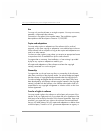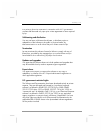
156 | hp Jornada 560 series personal digital assistant User’s Guide
Intranet. A network that offers services similar to the Internet, but usually
accessible only to users within a single company or organization.
IP (Internet Protocol). The standard by which packets of information
are transmitted over the Internet.
IrDA (Infrared Data Association protocol). An established standard
for infrared communications between computers and other peripherals and
devices.
ISP (Internet service provider). A commercial business that provides
Internet access to individuals or businesses, usually for a fee.
LAN (local area network). A group of computers, usually in close
proximity (either in the same building or in buildings in close proximity),
that are linked together to share files and exchange data.
Modem. A communication device that enables a computer to transmit
data over telephone lines.
NIC (network interface card). A card installed in a computer so that
it can be connected to a network. NICs can provide a dedicated, full-time
connection to a network.
Partnership. An established relationship between your hp Jornada and
your desktop PC for the purpose of synchronizing and transferring data.
PIM (personal information manager). An application or set of
applications that organizes information such as addresses, appointments,
and notes.
POP3 (Post Office Protocol v3). A protocol that enables a computer
to retrieve messages from a mail server.
PPP (Point-to-Point Protocol). The default method your hp Jornada
uses to communicate with an ISP or network server.
Proxy server. A server that sits between a client computer or Web
browser and the Internet. A proxy server provides security by filtering
requests and can improve performance by storing local copies of
requested information.
RAM (random access memory). Volatile memory that can be read
and written. Data stored in RAM is retained only while power is
maintained.


















